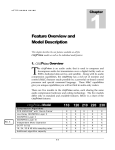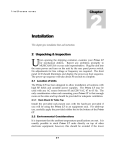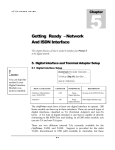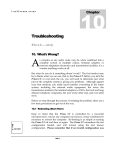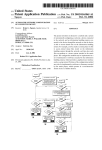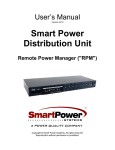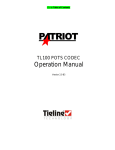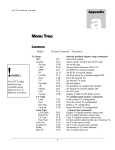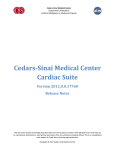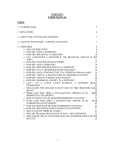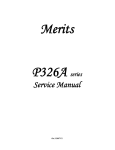Download Prima LT User's Guide
Transcript
Prima LT U S E R S 5 Chapter G U I D E Getting Ready – Network And ISDN Interface This chapter discusses all that is needed to interface your Prima LT to the digital network 5. Digital Interface and Terminal Adapter Setup !note: You can skip this section if your Digital Interface Module was factory installed or you are using an internal terminal adapter. 5.1 Digital Interface Setup Interface MENU NAVIGATION External TA Dig. Interface X.21 V.35 RS422 DTR/CON COMMAND WINDOWS RC DESCRIPTION <Interface><Dig Interface> <type><DTR/CON> CDT Setup, Digital Interface Set state of the DTR/CON line <Interface> CIF Setup, Digital Interface Select digital interface type The Prima LT needs a digital interface to operate. There are several types of digital interfaces, classified as TA (Terminal Adapter) and nonTA types. A TA type of digital interface is one that is capable of directly connecting to the ISDN line and dialing. There are two different internal TAs currently available for the Prima LT, TA201 and TA301. Support is provided for the older TA101, discontinued in 1996 (still available in Australia), but these terminal adapters are no longer available from MUSICAM USA. There are several different Non-TA type interfaces that can be used with the Prima LT: 5-1 Prima LT U S E R S G U I D E • X.21 • RS422 • V.35 The RS422 and X.21 protocols have the same voltage levels and thus both share the same interface card, the DIF101. Setting jumper P4 on the DIF card makes the distinction between them. Position 1 and 2 should be shorted for X.21 operation, and position 2 and 3 should be shorted for RS422. The V.35 standard specifies different voltage levels and hence must use a different type of line interface IC. The interface card used for this standard, the DIF102, is therefore different from the interface card for the X.21/RS422 standard. !note: A digital interface must be defined before it can be used. The CIF command, <Interface><select> is used to define and enable the type of digital interface that has been installed in the Prima LT. Please remember that each installed interface card has two ports, and that each port must be defined. Some models of external terminal adapters can use the state of the DTR/CON line to terminate a connection. If your external terminal adapter or CSU/DSU can do this, use the X.21XTA or V.35XTA setting, whichever is appropriate. This enables the user to terminate the connection by pressing the END key on the front of the Prima LT. Otherwise, use the X.21 or V.35 setting. On some non-TA interfaces, there is a signal designated DTR for the V.35 interface and CON for the X.21 interface. These are control lines from the Prima LT interface card to the external terminal adapter equipment. The levels of these lines are controlled by the CDT command, <Interface><Dig Interface><type><DTR/CON>. Some external ISDN terminal adapters and Switched-56 CSU/DSUs require that the DTR/CON line is asserted. The CDT command provides an easy method of controlling the state of the DTR/CON line. If your Prima LT was delivered with the digital interface installed by the factory, the modules have already been set up. You should, however, check to see that non-TA type interfaces have been set up 5-2 Prima LT U S E R S G U I D E properly for your application. In addition, after any reset of default values, you will have to re-install all DIF modules. 5.2 Terminal Adapter TA101 Configuration. If an internal terminal adapter is not used, you can skip the remainder of this chapter. !note: TA101 Interface Sw Type Appropriate setup information Initialize Save Internal TA The TA101 terminal adapter provides one S/T interface for one ISDN BRI (2 x 64 kb/s) line. In North America, the Telco provides a ‘U’ interface; therefore, an external NT-1 must be used between the Prima LT and the wall jack. Elsewhere, the Telco provides an S/T interface and an external NT-1 is not needed. The TA101 requires country specific ROM chips for use in different countries. Please contact MUSICAM USA, CCS-Europe or your local distributor for information if you plan to take your Prima LT to a different country. Although your Prima LT does support the TA101 terminal adapter, the TA101 has been discontinued and is no longer available from MUSICMA USA. Please contact MUSICAM USA or refer to the CDQPrima Users Guide, available on-line at www.musicamusa.com, for configuration information. 5.3 Terminal Adapter TA201 and TA301 Configuration for North America Interface Internal TA TA201 TA301 MENU NAVIGATION <Interface><Internal TA><TA201> <country> Switch type, SPIDs, IDs, Interface mode and Lower Layer control are set in sequence after terminal adapter type is selected Country Sw Type Appropriate setup information Initialize Save COMMAND WINDOWS RC CCC N/A CLD TA, Configuration Set ID for a Terminal Adapter CLL TA, Configuration Set Lower Layer Control for Terminal Adapter CSI TA, Configuration Set SPID for a Terminal Adapter CSW TA, Configuration Set switch type 5-3 DESCRIPTION Define country for TA201 Prima LT U S E R S G U I D E MENU NAVIGATION <Interface><Internal TA> … <Initialize> COMMAND WINDOWS RC CTF TA, Configuration CTR N/A DESCRIPTION Set TA interface mode Reset the adapter internal terminal The TA201 terminal adapter provides one S/T interface for one ISDN BRI (2 x 64 kb/s) line. In North America, the Telco provides a ‘U’ interface, therefore an external NT-1 must be used between the Prima LT and the wall jack. Elsewhere, the Telco provides an S/T interface and an external NT-1 is not needed. The TA201 contains all country specific configuration and provisioning information in memory, and there is no need to change ROM chips when using your Prima LT in a different country. The TA301 is similar the TA201 except that it contains a built-in NT-1 and connects directly to the ISDN ‘U’ interface provided in North America. No external NT-1 is required. Prima LT’s top-down terminal adapter configuration menu does not require unnecessary information, and only those parameters appropriate for the terminal adapter type and country setting are required. Probably the most confusing aspect of ISDN codecs is configuring the Terminal Adapter for the ISDN in your area. This is especially true in North America, where there are several local ‘flavors’ of ISDN that are all provisioned differently. Elsewhere, configuration of the terminal adapter may be as simple as insuring the proper country is selected. In North America, the ISDN service provider must supply certain information to allow you to correctly configure the Terminal Adapter: • ISDN ‘Flavor’, e.g. National ISDN or Custom. • Service Provider Identification Numbers (SPID numbers). National ISDN always requires SPID numbers; some locations using Custom ISDN may not require SPID numbers. If SPID numbers are required, most areas use two, but some implementations require only one. The following parameters are entered in sequence. You can exit the TA programming sequence at any time by pressing the up arrow button. 5-4 Prima LT U S E R S G U I D E 5.3.1 Select Country (TA201 Only) Since the TA201/TA301 have all country specific protocols in ROM, you must select which of these protocols to use. Use the keypad sequence <Interface><Internal TA><TA201><country> or the CCC command. 5.3.2 Switch Type It is necessary to tell the TA what type of switch protocol is being used at the Telco central office. The ISDN service provider will give this information to you. You need to set the switch type only once for each TA since it is impossible to have different switch types for the individual “B” channels in an ISDN line. Go down the <Interface><Internal TA> … <Sw type> branch then select the appropriate switch type, either National or AT&T Custom. The CSW command is used for setting the switch type from a terminal. !note: Select ‘5ESS CUST’ only for AT&T custom point-to-point or point-tomultipoint ISDN service available in a limited number of areas in the United States. For all other ISDN service, including AT&T National ISDN, select ‘NI1’. 5.3.3 Service Provider ID (SPID) Number After the switch type is entered, you will then be prompted to enter two SPID numbers. !note: For most areas in North American, the TA must be told the SPID number of the calling ISDN line, that is, the line to which the Prima LT is connected, i.e., your ISDN line. The ISDN service provider in your area provides this number to you. It is important to remember that every time the Prima LT is moved, or whenever there is a change in the ISDN line, or even area code changes, the SPID and ID number, switch type and possibly other parameters for the TA setup must be updated. The Prima LT can store up to 20 ISDN location configurations for later recall. Follow the prompts to enter the SPID numbers for both ‘B’ channels. Please note that some implementations of AT&T Custom ISDN may require only one SPID number or may not use SPID numbers at all. In 5-5 Prima LT U S E R S G U I D E these cases, simply press ENTER to go to the next setup parameter. Use the CSI command to set the SPID number from a terminal. If SPIDs are not used in your area, line 2 may answer the first incoming call, line 1 will answer the second. Once both SPID numbers are entered you will be prompted to enter ID numbers. 5.3.4 Identification (ID) Number If you are required to use two SPID numbers, then you must use ID numbers. For North American operation of the TA201 and 301, the ID number is just the seven-digit ISDN line number connected to the Prima LT. Follow the prompts to set the ID from the keypad or use the CLD command from a terminal. At this point, all required information has been entered. You will only need to continue the programming sequence if your ISDN service is not functioning properly or if your TA201 was previously used in a different country. Press the up arrow button to reach the top of the menu tree to exit the programming sequence. 5.3.5 Interface Mode !note: The CTF command sets the interface mode of the internal TA201 and TA301. For North American operation with the TA201 or TA301 the mode should always be set to ACTIVE. This parameter is factory set if your terminal adapter was installed by MUSICMA USA and was purchased for use in North America. 5.3.6 Low-Layer Control (LLC) The CLL command is used to set the Low Layer Control protocol used by ISDN. When the LLC is set to ON, both 56 and 64 kb/s dialing is allowed. When the LC is set to OFF, only 64 kb/s dialing is permitted. 5.3.7 Initialize (Reset TA) After the above parameters have been set, it is necessary to reset the terminal adapter. The CTR command is used to reset the internal terminal adapter. The TA201 and TA301 currently return no information after a reset. Please note that a complete reset of the TA201 and TA301 terminal adapters takes about 45 seconds, and you should not attempt to dial before the reset is complete. 5-6 Prima LT U S E R S G U I D E 5.4 Terminal Adapter TA201 Configuration, Non-North American Operation Interface Internal TA TA201 MENU NAVIGATION <Interface><Internal TA><TA201> <Country> Switch type, LDNs, sub address, Interface mode and Lower Layer control are set in sequence after country is selected. Not all parameters are required for all countries. <Interface><Internal TA> … <Initialize> Country Sw Type Appropriate setup information Initialize COMMAND WINDOWS RC DESCRIPTION CCC N/A CLD TA, Configuration Set LDN/MSN for a Terminal Adapter CLL TA, Configuration Set LLC state (United Kingdom) CSA TA, Configuration Set sub-address for a Terminal Adapter. CSW TA, Configuration Set switch type CTF TA, Configuration Set TA interface mode CTR N/A Define country for TA Reset the internal terminal adapter The TA201 terminal adapter provides one S/T interface for one ISDN BRI (2 x 64 kb/s) line. The TA201 contains all country specific configuration and provisioning information in memory, and there is no need to change ROM chips when using your Prima LT in a different country. Use the Germany setting for most of Europe, except France and the U.K. 5.4.1 Select Country !note: Save Since the TA201 has all country specific protocols in ROM, you must select which of these protocols to use. Use the keypad sequence <Interface><Internal TA><TA201><country> or the CCC command. For countries not specified in the selections, try using Germany, with DSS1 Switch type. For Pacific-Rim countries, try using Japan settings. 5.4.2 Switch Type (Germany Only) If Germany is selected, it is necessary to tell the TA what type of switch protocol the PTT central office is using. The ISDN service provider will give this information to you. You need to set the switch type only once 5-7 Prima LT U S E R S G U I D E for each TA since the switch governs both ‘B’ channels in an ISDN line. Select the appropriate switch type, either DSS1 or 1TR6. The CSW command is used for setting the switch type from a terminal. 5.4.3 LDN / MSN Number The MSN (Multiple Subscriber Number) allows you to connect several codecs (terminal adapters) to one ISDN bus if the DSS1 Euro-ISDN protocol is used. Each TA201 interface requires two MSN numbers, one for each 64 kb/s channel. You do not need to enter the whole MSN, you just have to enter the last different digits. For example, if your MSN for line 1 is 8115517571 and for line 2 is 8115517581, then you only need to enter ‘71’ and ‘81’ for the MSNs. 5.4.4 Sub-Address And Interface Mode Sub-addresses are required when using the German 1TR6 switch protocol. Like the MSN used with DSS1, the sub-address enables you to connect several codecs (terminal adapters) to the same ISDN bus. For every terminal adapter, you need two sub addresses (EAZ numbers), one for each 64 kb/s channel, numbers between 1 and 8. The Prima LT’s interface mode has a different meaning for the TA201 terminal adapter when not used in North America. Try setting the interface mode to ACTIVE, and if you have trouble making or receiving calls, set the interface mode to IGNORE. All of the terminal adapter parameters discussed so far can be entered at the same time when using the available Windows Remote Control program. 5.4.5 LLC (Low Level Command) State (UK Only) It is only necessary to set the LLC state in the United Kingdom. Different areas in the UK require different settings. If your TA201 cannot dial properly with the default setting, toggle the setting. Remember that you must set each DIF (B channel) to the proper state. 5.4.6 Initialize (Reset TA) After the above parameters have been set, it is necessary to reset the TA201 Terminal Adapter. The CTR command is used to reset the internal terminal adapter. The TA201 and TA301 currently return no information after a reset. 5-8 Prima LT U S E R S G U I D E 5.5 Terminal Adapter Configuration Storage and Recall Interface MENU NAVIGATION Advanced I/F Load TA Setup Save TA Setup Delete Entry Clear All COMMAND WINDOWS RC CTA N/A Loads a previously stored TA configuration CTA N/A Prints first stored TA configuration CTB N/A Display TA configuration description <Interface><Advanced I/F> <Del entry/clear all> CTD N/A Erases one or all stored TA configuration <Interface><Advanced I/F> <Save TA Setup> CTE N/A Saves the current TA configuration CTN N/A Prints next stored TA configuration <Interface><Advanced I/F> <Load TA Setup> DESCRIPTION It is possible to store up to 20 terminal adapter configurations for later recall. This feature makes it easy to reconfigure your terminal adapter when your Prima LT is used in multiple locations. Each stored configuration includes up to two SPID and ID numbers, local check values, switch types, sub-addresses and all relevant TA setup parameters. Once your TA has been configured and is working properly, we recommend that you store that configuration for later recall using the CTE command. You will be asked to enter a descriptive name, up to 20 characters (no spaces), and the Prima LT will assign an identification number to the entry. To recall the configuration, use the CTA command. To delete one or all of the stored configurations use the CDT command. To list all stored configurations on a terminal, use the CTA, CTB and CTN. Please note that you can reload a stored configuration only into the same type of TA. You cannot save a TA101 configuration and reload it into a TA201 Fhint: 5-9 Prima LT U S E R S G U I D E We recommend that you always save your TA configuration after you are satisfied that it works. This will save you time and effort if you must later reload the configuration. 5.6 Other TA Parameters Interface MENU NAVIGATION Auto Answer Auto Reconnect Redial Advanced IF Dial Time Out Alpha Mode I/F Loopback TA Version COMMAND WINDOWS RC DESCRIPTION <Interface><Advanced I/F> <Auto Ans> CAA N/A Set TA auto answer mode <Interface><Advanced I/F> <AutoReCon> CAC TA, Settings Set TA auto reconnection state <Interface><Advanced I/F> <I/F Loopback> CLB <Interface><Advanced I/F> <Redial> CRD TA, Settings Set number of redial attempts <Interface><Advanced I/F> <Dial TO> CTO TA, Settings Set dialing time-out <<Interface><Advanced I/F> <TA Version> CVR N/A Set digital interface loopback Print terminal adapter ROM version The CAA command can be used to switch the TA out of the auto answer mode. If the TA is not in the auto-answer mode, then it will not accept any incoming calls. The factory default is set to auto-answer. This feature is useful if you want to prevent anyone from dialing into your Prima LT. !note: If you call another codec and the connection is lost, it is possible to have the Prima LT automatically redial the connection. This is done by setting AutoReCon to YES using the CAC command. This is a very powerful feature when less than ideal lines are used. Remember, however, that when this feature is enabled, only the calling Prima LT can terminate the connection. 5-10 Prima LT U S E R S G U I D E The CRD command (Redial) sets how many times the Prima LT will attempt to establish connection before giving up. The factory default is 1 redial attempt, i.e.; the Prima LT will dial each connection twice. The dial time-out command CTO (Dial TO) sets the time that the Prima LT waits for a connection to be established before giving up. Regardless of the number of redial attempts selected, you can abort the dialing sequence anytime after the first attempt by pressing the ↑ key. It is possible to loop back at the internal terminal adapter or other digital interface using the CLB command. Digital interface loopback can be used as a troubleshooting tool. The CVR command can be used to display the terminal adapter software version for a TA201 or TA301 terminal adapter (ROM version). 5.7 Digital Interface Connect Time And Status Interface Connect time LCD Displ Dspl Time Clr Time Dspl Num A digital interface can be in one of three states: • • • DISCONNECTED DIALING (TA type only) CONNECTED The state of the digital interface is shown by the 2 DIF LEDs on the front panel. If the LED is dark, then the state of the DIF is DISCONNECTED, and if the LED is illuminated, then the DIF is CONNECTED. Certain non-Terminal Adapter interfaces will always be in the connected state. Although the connect time is displayed on the encoder and decoder status screens (pressing the E STAT or D STAT buttons), you can also display the connect time, in full HH:MM:SS format, without loading the status displays. To show the connect time, first turn on the display using the CDC command: <Interface><Connect Time><LCD Display> then, send the connect time to the display using the CCS command: <Interface><Connect Time><Display Time> 5-11 Prima LT U S E R S G U I D E You can reset the connect time display to zero at any time by issuing the CCR command: <Interface><Connect Time><Clear Time> It is also possible to show the last number dialed, and the bit rate used to make the call by using the CCD command: <Interface><Connect Time><Display Num> 5-12













